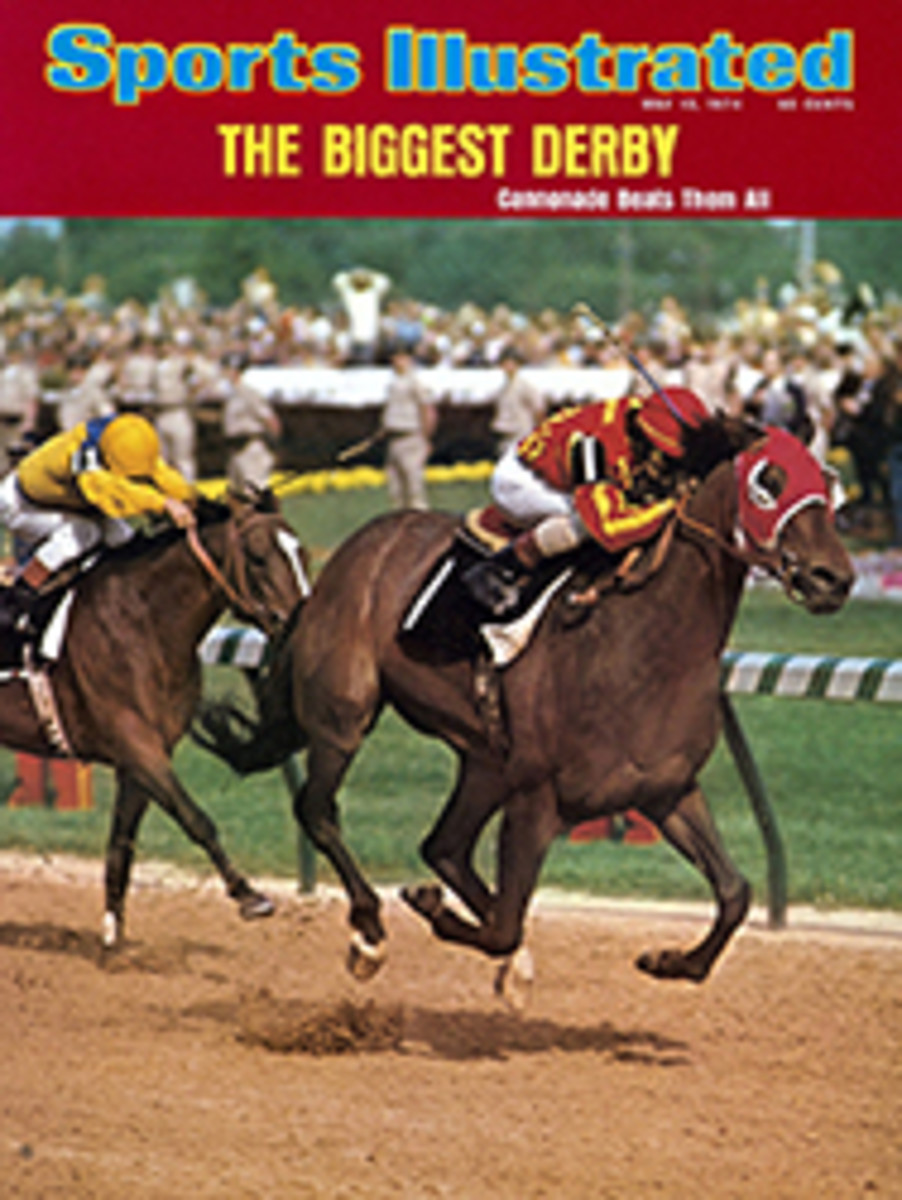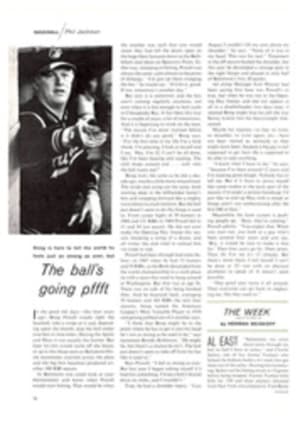
It Takes a Little Distance...
There has been a lot of chatter lately about the surfaces upon which sports are played, and it sometimes leads me to wonder just how the Davis Cup, for example, would have worked out had it ever been contested on my grandmother's tennis court in St. Louis. Built in the teens of this century, it was the snappiest thing in all-weather courts. It was made of gravel. The theory behind this, which made sense to me at the time, was that maintenance would be so simple. My father and uncle said so, as they discussed getting it into shape and teaching their offspring how to play tennis upon it. As seemed to be usual with adults, they directed operations while my sister and I, with our cousins Jim and Joe, pulled the weeds, father and uncle having come fortified for the ordeal with tall, frosted glasses.
There were several weekends of this, as the court was a jungle of weeds apparently thriving essentially on rocks. Beneath the gravel lay only a thin layer of soil, with large stones as a bed, supposedly for drainage, and a yank at some 98-pound weakling of a weed usually produced its friend the rock clutched in its roots. The result of our efforts was thus a cratered and pockmarked court requiring careful reburial of a lot of stones followed by the sweeping of dirt and gravel back into place with what were, by this time, grubby and rather sore little paws. Despite our modest protests that this surface was quite good enough for us, and we were ready and eager to play upon it, we would still have to go over the court with a bamboo rake and then a roller produced from the garage—rusty, but unfortunately still usable.
This program was the rite of spring for about 10 years, and the novelty of it soon wore off. The four of us were driven to the most extreme cunning to either duck the drudgery or Tom-Sawyer an innocent friend into it.
There was one chore we really did not mind. This was filling the marker with lime and tracing the lines, the lime at first rushing out in thick spurts, then making thinner and dimmer lines as the marker emptied. The result, depending on where you were playing (we did ultimately get to play), was that either puffs of white powder would dance at the touch of ball or foot, or you squinted down the court trying to find the baseline. But such subtle refinements were not an important part of our game. We were too busy making futile attempts to push back the rambler roses adorning the chicken wire stretched between the four-by-fours that enclosed the court. When the court was marked for doubles, those roses were a menace. There was only a foot between the sidelines and the flower-festooned wire, and anyone running for a ball near the line ended up tangled in thorns. After a session of play, participants looked more like survivors of some fearful disaster than competitors in a so-called friendly game, with bloody scratches on the arms and legs protruding from their shredded tennis dresses and torn shirts and shorts. My grandmother's was probably the only tennis court in the U.S. that needed a permanent first-aid station. If the roses didn't get you, the gravel would. Many a time-out was called while someone retired to the house to pick pebbles from knees, elbows or the palms of hands. Oh, that sting of alcohol. Oh, to have had stock in Band-Aids!
Still, possibly because we were not often spoiled by a chance to play elsewhere, we loved it. After a hard-fought session in the St. Louis heat we would flop on the grass behind the court under the apple trees and cool off, or go to the house for lemonade and find, carefully hidden behind the cookie jar, some forbidden cigarettes. We never dared to smoke inside. We would make our way to the edge of the property, between the trees and the grape arbor, for our secret puffs. Refreshed, we could return to play, with no crowds to wait for and no critical spectators, except perhaps for the small children of the neighborhood or the elderly Irish priest from the parish, who was in the habit of taking his daily walk past my grandmother's. He usually paused to watch, and would walk away shaking his head. We never knew if this was a comment on our game or our attire. I expect he didn't approve of either. Our clothes were the standard summer wear of the time, but "standard" was not quite the word for our game.
One reason for the latter was the fact that although the ground had been "leveled," at one end of the court there was a small grassy hill. The player there had a wonderful advantage—on lobs, he ran up the hill and could send back a terrific overhead smash. When I was playing with my sister and I had the hill, she would simply throw down her racket at that point, put her hands over her head and wait. I did the same when I was on the receiving end.
We finally got used to the erratic bounce of balls off gravel, but the years went by and the court became barer and barer as storms washed the surface away. Now the balls were sliding strangely on the muddy underspill, and the bedrocks seemed to grow, sometimes overnight. Slyly, they would stick up sharp points, suitable for tripping over; if the ball happened to hit one, it would rocket off in a direction equally unexpected by server and receiver. And the roses were winning. They came to form a sort of overhanging eave, waiting to gobble up any wild shot, often refusing to disgorge their prey even to thrown rackets and fierce shakings of the four-by-fours.
My sister was by this time going out with the man she was eventually to marry, and after a few attempts at tennis at grandmother's, Ken led her off to the well-tended courts of Forest Park; the gravel, what was left of it, saw them no more. Perhaps they did have to wait in line at Forest Park, they explained, but there at least they were reasonably sure where a ball would go when they hit it. As for me, I had begun spending my summers with horses, and my cousins had dropped by the wayside. The court was virtually abandoned.
One spring day in 1945 my Aunt Helen went out and had a look at it. The four-by-fours were sagging, wavering back and forth in a tired serpentine, and the weeds were more vigorous than they had ever been. What she had on her hands, she realized, was a sporting slum. In a few weeks the court was demolished, the gravel sodded over and the area turned into—what else?—a rose garden.

